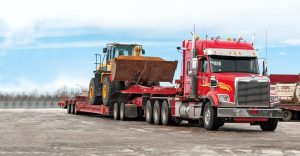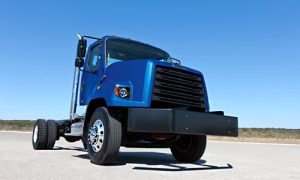Heavy Duty Trucks & The Construction Industry
Here at Tracey Road Equipment, we know both the trucking and construction industries, so we see first-hand how the two are interconnected. In recent years, we have all seen tremendous changes in the design and manufacturing of heavy duty trucks, and we’ve noticed trends that can (or should) significantly impact the decisions you make when buying trucks for your construction business.
OEMs have made great strides in streamlining over-the-road trucks so they deliver important time and money savings. If you could capture those savings, too, you’d be money ahead. And in the construction industry, money can be hard to come by.
As a contractor, you use trucks for two distinct purposes.
 Some – dump trucks, for instance — earn revenue directly as part of your jobsite equipment “crew.” But some play a supporting role, used mainly to haul equipment to work sites. That affects your accounting and cost analysis of truck performance. Expenses for support vehicles are allocated to all the projects they support, whereas on-the-job vehicles are expensed entirely to that single job.
Some – dump trucks, for instance — earn revenue directly as part of your jobsite equipment “crew.” But some play a supporting role, used mainly to haul equipment to work sites. That affects your accounting and cost analysis of truck performance. Expenses for support vehicles are allocated to all the projects they support, whereas on-the-job vehicles are expensed entirely to that single job.
Cost distribution affects your payback period as well as your overall return on investment in that truck. Here’s how you can use trends in over-the-road trucking to make the smartest purchasing decision when you’re in the market for a new construction truck:
“Value” trucks.
OEMs know you don’t always need all the amenities now available for heavy duty trucks. They’re nice to have, but they drive up the truck’s price. But before you jump at the chance to save money on a pared-down vehicle, consider whether you might regret later on not having some of those amenities. Driver comfort, particularly, can affect productivity and even desire to keep working for you. So how much time will drivers be spending behind this truck’s wheel?
On the other hand, if you’re buying a truck for its hauling capabilities, power and reliability should be your primary focus. Consider saving money with a Class 8 truck that has a smaller engine.
Super Truck.
 Daimler and other OEMs are investing heavily in this government initiative created to cut freight hauling fuel consumption by 50%. On the surface, this has nothing to do with the construction industry. You never travel long distances like over-the-road trucking companies, and much of ground your trucks cover is unpaved. So who needs all that costly new technology?
Daimler and other OEMs are investing heavily in this government initiative created to cut freight hauling fuel consumption by 50%. On the surface, this has nothing to do with the construction industry. You never travel long distances like over-the-road trucking companies, and much of ground your trucks cover is unpaved. So who needs all that costly new technology?
But there’s more to SuperTruck advances, and some of those features could benefit you, too:
- Smaller but more efficient engines reduce weight.
- Bodies and lift systems made of lighter materials reduce weight without sacrificing durability.
- Reducing idle time and running only engine-driven compressors, pumps, etc. saves fuel.
- Some aerodynamics features can help even at slower speeds.
- Telematics can lower your maintenance costs and down time.
Downsized engines.
Bigger isn’t necessarily better, and it’s usually more expensive. That’s why truck manufacturers have worked diligently in recent years to “right size” engines, producing smaller displacement products that deliver equal or better performance to past versions. Any truck that doesn’t have to meet continuous high-demand workloads can help you cut fuel costs without losing the power and torque you need.
Downspeeding.
Along with reducing engine size, OEMs have worked to better integrate engines with powertrains and transmissions, producing all-in-one units that function more smoothly. You get improved performance and fuel economy with reduced engine wear. If this is for you, you’re your next engine based on its torque curve.
Making sure the body fits.
All the changes OEMs have been making to the power-end of trucks have created greater complexities at the back end as well. If specs don’t match up, your body builder or upfitter is going to have a tough time. So make sure you communicate your precise needs at the time you spec your new truck.
